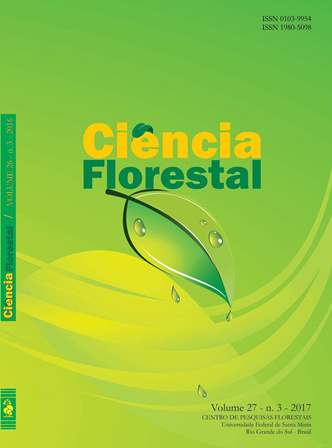THE INFLUENCE OF HEAT TREATMENT ON BIOLOGICAL DEGRADATION OF <i>Eucalyptus grandis</i> AND <i>Pinus taeda</i> WOOD
DOI:
https://doi.org/10.5902/1980509828672Keywords:
biodegradation, heat treatment, white rot, brown rot.Abstract
This study investigated the effect of two thermal treatment technique on the biological properties of the wood of Pinus taeda L. and Eucalyptus grandis and W. Hill ex Maiden, comparing them with results obtained for the untreated wood. Of each species were sampled three trees at age 25, from where it drew a central plank height DBH for making test specimens were subjected to thermal treatments for later be transformed into pieces of 2.5 x 2.5 x 0.9 cm. In the first treatment the wood were subjected to thermal treatment by autoclaving at 130 ºC/ ± 3 ° C and pressure of 2 kgf /cm² for 3 hours and, after a conditioning period, subjected to heat in an electric oven at 160 °C/ ± 1 °C for the same period. The second treatment consisted of only heat treatment by kiln. Resistance to biological attack was evaluated by accelerated decay test in the laboratory, using a white-rot fungus, Trametes versicolor (Linnaeus ex Fries) Pilat and other brown rot Gloeophyllum trabeum (Persoon. ex Fries) Murr. The combined treatment of the autoclave with electric oven favored the decay of both species of wood fungi employees, except for Pinus taeda submitted to the fungus Trametes versicolor, while treatment in an oven provided increase biological resistance of Pinus taeda wood fungus Trametes versicolor and of Eucalyptus grandis fungus Gloeophyllum trabeum. In general it is concluded that treatment in an oven resulted in more resistant to biological degradation and lower weight loss compared with the combined treatment of the autoclave with electric oven when observed the ineffectiveness of thermal treatment while the latter when applied to both species resulted in an increase in the propensity of biological degradation.
Downloads
References
AMERICAN SOCIETY FOR TESTING AND MATERIALS. ASTM D 2017. Standard method for accelerated laboratory test of natural decay resistance of woods. Philadelphia, 2005. 5 p.
BRITO, J. O. et al. Densidade básica e retratibilidade da madeira de Eucalyptus grandis submetida a diferentes temperaturas de termorretificação. Cerne, Lavras, v. 12, n. 2, p. 182-188, 2006.
DOI, S. et al. Changes of decay and térmite durabilities of Japanese larch (Larix leptolepis) wood due to high temperature kiln drying processes. Journal of Wood Science, Japan, v. 51, n. 5, p. 526-530, 2005.
ESTEVES, B. M.; DOMINGOS, I. L.; PEREIRA, H. M. Pine wood modification by heat treatment in air. BioResources, Amsterdã, v. 3, n. 1, p. 142-154, 2008.
JOHANSSON, D. Heat treatment of solid wood: effects on absorption, strength and colour. 2008. 142 f. Doctoral thesis (Divisions of wood Physics) – Lulea University of Technology, Sweden, 2008.
KORKUT, S.; BEKTAS, I. The effects of heat treatment on physical properties of Uludag fir (Abies bornmuelleriana mattf.) and Scots pine (Pinus sylvestris L.) wood. Forest Products Journal, Madison, v. 58, n. 3, p. 95-99, 2008.
MARTÍNEZ, A. T. et al. Biodegradation of lignocellulosics: microbial, chemical, and enzymatic aspects of the fungal attack of lignin. International Microbiology, New York, v. 8, n. 3, p. 195-204, 2005. Disponível em: <http://www.ncbi.nlm.nih.gov/pubmed/16200498>. Acesso em: 3 jan. 2010.
MOHEBBY, B.; SANAEI, I. Influences of the hydro-thernal treatment on physical properties of beech Wood (Fagus orientalis). In: ANNUAL MEETING BANGALORE, 36., 2005, India. Anais eletrônicos... India: Tarbiat Modarress University, 2005. Disponível em: <http://www.modares.ac.ir/file/IRG05-Mohebby.pdf?p=UxFL0lSRzA1LU1vaGViYnkucGRmLjI1NDY4MV9QQVRI&n=SVJHMDUtTW9oZWJieS5wZGY->. Acesso em: 25 dez. 2009.
PINCELLI, A. L. P. S. M.; BRITO, J. O.; CORRENTE, J. E. Avaliação da termorretificação sobre a colagem da madeira de Eucalyptus saligna e Pinus caribaea var. Hondurensis. Scientia Forestalis, Piracicaba, v. 1, n. 61, p. 122-132, 2002.
PRATES, E. M. B.; COSTA, A. F.; GARLET, A. Efeito de tratamentos térmicos sobre a resistência biológica da madeira de marupá, louro vermelho e jequitibá rosa. In: CONGRESSO DE INICIAÇÃO CIENTÍFICA DA UNIVERSIDADE DE BRASÍLIA, 15., 2008, Brasília. Anais eletrônicos... Brasília: UnB, 2008. Disponível em: <http://www.unb.br/administracao/decanatos/dpp/pibic/Programacao_de_Iniciacao_cientifica_2009.pdf>. Acesso em: 15 jan. 2010.
SEVERO, E. T. D.; TOMASELLI, I. Efeito do tratamento de vaporização em toras e madeira serrada de Eucalyptus dunnii sobre a flexão estática. Floresta, Curitiba, v. 29, n. 3, p. 37-51, 2003.
SILVA, M. R.; MACHADO, G. O.; GOMES JUNIOR, C. C. Efeito do tratamento térmico nas propriedades mecânicas de Pinus elliotti. In: ENCONTRO BRASILEIRO EM MADEIRA E ESTRUTURAS DE MADEIRA, 11., 2008, Londrina. Anais... Londrina: UEL; EBRAMEM, 2008.
SILVA, P. H. M. Tratamentos prolongam uso da madeira. Revista da Madeira, Curitiba, v. 17, n. 100, p. 78 – 80, 2006.
STAMM, A. J. Thermal degradation of wood and cellulose. Industrial and Engineering Chemistry, Amsterdã, v. 48, n. 3, p. 413-417, 1956.
WANGAARD, F. F. The mechanical properties of wood. London: Chapman & Hall, 1950. 377 p.
WEILAND, J.; GUYONNET, R. Study of chemical modifications and fungi degradation of thermally modified wood using DRIFT spectroscopy. Holz Roh-Werkst, New York, n. 61, p. 216-220, 2003.







